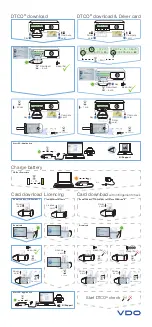
Operating Instructions
Chapter
10
CLV 490 Bar Code Scanner
8 008 796/0000/25-06-2002
©
SICK AG · Division Auto Ident · Germany · All rights reserved
10-53
Appendix
10.8.2
Calculating the start position and mirror speed for the forward and return
phase of the One-Shot function
Line scanner with oscillating mirror
Fig. 10-42: One-Shot: Line scanner with oscillating mirror: calculating the number of scans for fence-type bar code positioning
A
B
d
x
2
d
x
1
h
o
h
s
v
1. Focus position for distance configuration:
Theoretical calculation: reading from the front (object moving towards CLV)
Calculation for
Standard decoder!
Legend:
h
0
= Max. object height
h
S
= Distance of the CLV across conveyor level
ϕ =
Oscillating angle
α =
Max. angle of impact on bar code (skew)
Start Phase 1: Point A
Start Phase 2: Point B
γ =
90
°
–
α
ϕ γ
+
(
)
h
s
h
0
–
(
)
d
-------------------------
=
cos
ϕ
arc cos
h
s
h
0
–
(
)
d
---------------------------
γ
–
=
StartPos 1
50 CW
ϕ
2
----
1 CW
0.5
---------------
×
+
=
sin
α
h
s
d
-----
=
⇒
d
h
s
α
sin
-------------
=
StartPos 2
50 CW
ϕ
2
----
1 CW
0.5
---------------
×
–
=
2. Oscillating angle
ϕ
When entering the values, note the following:
– Debouncing time of the Sensor 2 switching input
(One-Shot trigger)
– Start time of the oscillating mirror
(inertia)
¾
Select the mirror speed of the return phase, in accordance
with the distances between the objects, so that the scan
line returns to the starting position (Point A) at the right
time.
¾
Check the theoretically calculated values on site and adapt
them if required.
3. Mirror speed
ϕ
*)
:
v
∆
x
∆
t
-------
∆
x
x
1
x
2
–
=
;
=
ϕ
*
∆ϕ
∆
t
--------
=
∆
x
v
-------
∆ϕ
ϕ
*
-------
=
⇒
ϕ
*
∆ϕ
v
∆
x
-------
×
where
1 °/s = 2 CW/s
=
¾
Enter
ϕ
symmetrically to CW = 50:
(Scanning direction is vertical to drawing plane)
Specified values:
h
S
> h
0
α ≤
45
°
(better:
α ≤
30
°
)
Set max. deflection angle:
±
20
°
¾
Determine distances through measurement:
x
1
= Distance at Start Phase 1
x
2
= Distance at Start Phase 2
During the period
∆
t, in which the object moves from x
1
to x
2
the oscillating mirror must also pass through the angle
∆ ϕ
















































